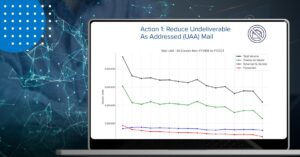Enhancing Address Quality by Understanding Return Codes
Table of Contents
View Return Codes Quick Reference Guides
BCC Software’s Customer Support department often fields questions about address correction results and how these explain mail piece deliverability. While parts of this process are very straightforward, others are obscured by unclear descriptions, which is why we want to take the time to focus on the different return code and address correction result combinations, and what they mean. This article will primarily reference the Return Code and DPV® confirmation fields – both are populated by CASS™, and Return Codes can be populated by NCOALink® in some cases.
Generally, when correcting addresses with CASS, there are two different levels of matching: First, do the City and State match the 5-digit ZIP™ provided? Next, do the street name and primary number (or street number) compare to various ZIP + 4® ranges assigned to that same 5-digit ZIP Code™?
Most ideal addresses have a Return Code 31 with a DPV Confirmation of Y. These have both a ZIP + 4 and Delivery Point populated and are confirmed matches to the USPS® postal tables. This means it’s known that the City, State, and ZIP match, and the primary number and street name matches to a specific ZIP + 4 range. It also means the specific delivery point, or the last two digits in the primary number, match to a specific entry in the CASS tables. An address with these results should always be deliverable.
Return Code 32 is generally deliverable, but it’s important to look at the DPV and consider any apartment or suite information in the record. Frequently this type of record will receive a DPV confirmation of S or D meaning they have a matching City, State, and ZIP and should get a ZIP + 4, in which the primary number should match to the range assigned to that specific ZIP + 4.
The issue lies when this primary number is noted to be an apartment building or office suite where these numbers still need to be assigned. Any suite or apartment information present in the address is not matching to the apartment information on file for this building. In BCC Mail Manager™, you can bring up the CASS table results, using the F7 shortcut, which will have apartment information. In most cases, the ZIP + 4 assigned by CASS will be information for the building and not the specific apartment.
Some records will also come back with a Return Code 31 but a DPV of S or D, which can be tricky because these addresses share many similarities with the Return Code 32 / DPV S or D addresses mentioned above. These records will have the right City, State, and ZIP, and the correct street name for the assigned ZIP + 4. But that does not mean there is a primary number that exactly matches the entry in the CASS database.
For example, if ZIP Code 14623-1234 has a primary number range for Josons Drive of 100-200, then 123 Josons Drive will likely get a Return Code of 31. However, if it returns a DPV of S or D, it can be assumed that the CASS table does not have the exact address of “123 Josons Drive” in the database. Just like with the Return Code 32 and DPV S or D, this record would just need a slight correction to re-encode as deliverable. Using the F7 ZIP Code search in BCC Mail Manager will provide the valid primary number range, but it will not have the exact primary numbers needed for a match.
Next, there are several cases that are similar enough to warrant mentioning together. These are Return Code 33, Return Code 31 with a DPV of N, and Return Code 31 with a DPV of Y but a CRRT of R777. These are all undeliverable results. Specifically, each of these has been marked by the USPS® to be undeliverable. These addresses often actually exist but are not marked as receiving mail for one reason or another – varying from new home construction or a house that the mail carriers cannot access. Whatever the reason, these records are deemed undeliverable and cannot be corrected.
Now for more complicated matters: Return Codes 21 and 22 do not explicitly mark addresses as undeliverable but do mean that something is missing or mis-entered, so there’s a chance the mail will not get to the correct location. These records should have a City and State that match to the 5-digit ZIP Code on the piece. They may have a valid street name for this 5-digit ZIP Code as well. The primary number, however, will not match to a ZIP + 4 range for this 5-digit ZIP Code. The deliverability of these addresses is questionable and therefore will not qualify for automation.
Lastly, there are Return Codes 10, 11, 12, 13, and 17 are undeliverable and indicate records where part of the address does not match any USPS record, or is invalid based on the information provided. Each Return Code represents a different portion of the address that is invalid:
- Return Code 10: Indicates invalid delivery address
- Return Code 11: Indicates invalid City/State/ZIP combination
- Return Code 12: Indicates the State is invalid related to the ZIP Code
- Return Code 13: Indicates the City is invalid related to the ZIP Code
- Return Code 17: Insufficient data or part of the address is missing
All of these Return Codes are undeliverable, but they often represent simple mistakes and are straightforward to correct.
This article only begins to scratch the surface of all of the information available from CASS, NCOALink, PCOA and ARS processed records. If you have any questions or are looking for more information, please reach out to our Customer Support department at 800-624-5234 or tech@bccsoftware.com.



